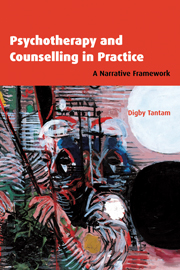Book contents
- Frontmatter
- Contents
- Preface
- A note on terminology
- Acknowledgements
- Introduction
- 1 Establishing the concerns
- 2 Values
- 3 What life means. Emotional flavour
- 4 Narrating the treatment: the formulation, reformulation and therapeutic contract
- 5 Narrating the self
- 6 Procedures for gaining relief
- 7 Resolution: finding out what's doing this to me
- 8 Universal technique for resolving predicaments
- 9 Relinquishment and releasement: changing something about me
- 10 Re-narration: finding happiness
- 11 Crises, and how to surmount them
- Appendix: confidential record
- References
- Index
4 - Narrating the treatment: the formulation, reformulation and therapeutic contract
Published online by Cambridge University Press: 06 November 2009
- Frontmatter
- Contents
- Preface
- A note on terminology
- Acknowledgements
- Introduction
- 1 Establishing the concerns
- 2 Values
- 3 What life means. Emotional flavour
- 4 Narrating the treatment: the formulation, reformulation and therapeutic contract
- 5 Narrating the self
- 6 Procedures for gaining relief
- 7 Resolution: finding out what's doing this to me
- 8 Universal technique for resolving predicaments
- 9 Relinquishment and releasement: changing something about me
- 10 Re-narration: finding happiness
- 11 Crises, and how to surmount them
- Appendix: confidential record
- References
- Index
Summary
Narrative approaches to psychotherapy have become rapidly established in family therapy (Sluzki, 1992), and are increasingly influencing individual psychotherapy. They recognize that the need to tell one's story is an important impulse for people in distress, and that telling one's story to a receptive audience lifts some of the burden of the events depicted in it.
Narratives bring together the three elements that we have already seen contribute to a person's concerns: actions, values and emotional meaning. Indeed, literary narratives have been viewed as responses to fundamental concerns, and a limited range of them at that. Illness is one of these concerns, and ‘taking a history’ is a narrative response to it which will be familiar to all doctors.
The ‘narrative turn’, as it has been called, in the intellectual life of the twentieth century reflected the weakening of a commonsense world of reality to be discovered, and replaced it with reality which was constructed and, potentially, deconstructed. The early psycho-analysts were strong influences on the development of the narrative approach because of their emphasis on the hidden reality of the ‘unconscious’. However, these early psycho-analysts were not free of their positivist inheritance, and believed that they were describing a psychic reality. Narrative theory has grown sufficiently large, however, to be able to bite the hand that fed it, and to challenge this reality. Surely, narrative theorists would argue, the unconscious is just another story?
- Type
- Chapter
- Information
- Psychotherapy and Counselling in PracticeA Narrative Framework, pp. 81 - 118Publisher: Cambridge University PressPrint publication year: 2002



